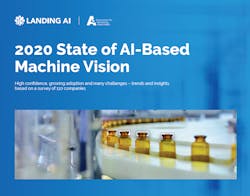Survey: Four Findings Show Manufacturing’s Opinion on AI Vision Inspection
The Association for Advancing Automation and Landing AI, an industrial AI company, released survey results of 110 manufacturing companies on the topic of AI-based vision inspection solutions. Their analysis included four key findings, which are highlighted in this article.
Finding 1: Manual Inspection is Still Important
Inspection is crucial in manufacturing across several industry verticals, and advancements in machine vision have allowed many facilities to rely on those technologies to take on the task.
According to the survey, 40% of respondents said their inspection was completely or mostly manual, while 24% said their visual inspections were completely automated.
Errors are associated with both manual and automated inspection methods. When asked what the biggest challenge is with their visual inspection method, 56% of respondents said that false calls were their biggest issue (a defective part was marked as good, and vice-versa). The inability to deal with complex surfaces/inspections accounted for 50% of responses, and the inability to deal with variation in what is being inspected accounted for 42%.
Finding 2: There is High Confidence in AI as an Inspection Tool
A widespread trend in manufacturing is the ability to customize mass-manufactured products. These product variances can present even more problems for manual inspection, and AI-based vision solutions can lend a hand. When given the selection of I don’t know, not effective, low, moderate, high and very high, respondents said their overall opinion of the effectiveness of AI were 12%, 2%, 4%, 28%, 39% and 15%, respectively.
When asked what the main benefits are of using AI-powered solutions, 62% of respondents said improved accuracy, followed by automating inspection tasks that had to be performed manually (48%) and dealing with variation in what is being inspected (45%).
Finding 3: Defect Data and Integration are Challenges
Versions of AI have been around for decades, but the technology has exploded in many different ways over the last few years. To be used to its full potential, AI has to be trained, which includes presenting various scenarios in which a part could be labeled defective. When asked what the largest challenges are when implementing AI-powered solutions, the scarcity of defect data to train AI was the largest percentile, with 62%. Some facilities lack the infrastructure needed to implement AI. 41% said the complexity of integrating AI with existing infrastructure was also a challenge.
The lack of common machine languages, scalability and the rapid evolution of AI are all contributors to slow adoption of this technology.
“Any AI/deep learning system purchased for the plant needs to have the flexibility to run third-party equipment/software, expand, upgrade and modify without investing a large amount of money in additional or new equipment,” said a respondent. “I do not want to purchase something that is outdated in six months.”
Finding 4: Companies Prefer Customized AI Solutions
Keeping on-trend with mass-customization manufacturing, businesses also prefer to have their AI-powered vision solutions customized to fit their needs. Due to cybersecurity concerns, many companies want to develop and manage their AI solutions in-house, but the lack of (and high cost of) AI developers frequently make the more cost-effective choice to rely on a vendor or buying a solution right off the shelf.
When asked how they would adopt an AI-powered vision inspection solution, 15% of respondents said they would want to buy off the shelf, 16% said they would work with a vendor, 26% said they would build and manage the solution in-house and 42% said they would want a combination of the previous three.
To download the full report, click here.

